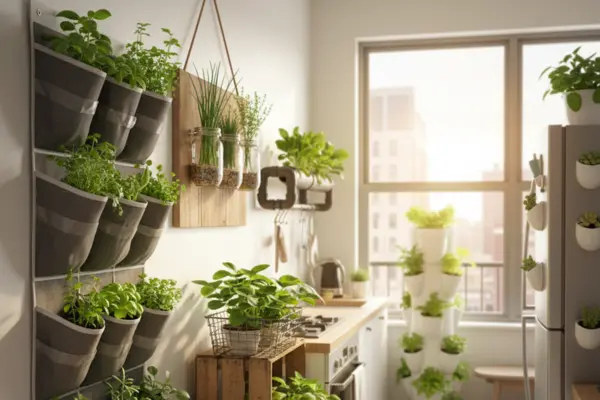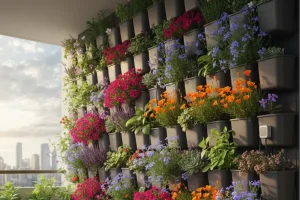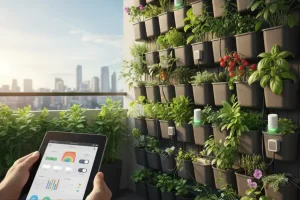Living in a small apartment doesn’t mean you have to give up your dream of gardening. Even with limited square footage, it’s possible to grow fresh herbs, flowers, and even vegetables by thinking vertically. With a few clever tricks, you can transform blank walls, windowsills, or balconies into lush, productive spaces.
In this article, we’ll explore practical, budget-friendly vertical gardening hacks designed specifically for apartment living.
Why Vertical Gardening Works for Apartments
Apartment living usually means two big hurdles: not much floor space and windows that don’t always give steady sun. Vertical gardening solves both by sending your plants up, not out. Shelves, pocket planters, and stackable towers turn an empty wall or balcony rail into productive square footage.
Because the garden is raised, you can slide it closer to a bright window, rotate it during the day, or pair it with compact LED grow lights so plants still thrive even on lower floors or north-facing units.
This style is also neat and renter friendly. Most systems are lightweight, modular, and easy to move when you change rooms or move out. Watering is simpler too: many vertical planters recirculate water, so you use less and avoid messy spills on floors and neighbors’ balconies. With plants off the ground, leaves dry faster and pests are easier to spot, which keeps maintenance low.
Vertical gardening in apartments offers:
- Fresh herbs and vegetables within arm’s reach for weeknight cooking
- Improved indoor air quality and humidity balance
- A natural, decorative feature that softens tight spaces
- Stress relief and a closer connection to nature, even in busy cities
- Privacy and light filtering on balconies without heavy curtains
- Better organization: each pocket can hold a crop with similar water needs
- Simple cleanup and quick replanting when seasons change
If you can spare a wall, a windowsill, or a balcony corner, you can grow a compact, tidy garden that looks good and actually feeds you.
Hack 1: Hanging Shoe Organizers as Planters
Repurpose fabric shoe organizers by hanging them on a wall or door. Each pocket can hold soil and a small plant.
Best plants: Basil, mint, parsley, lettuce.
Tip: Line pockets with plastic before adding soil to prevent leakage indoors.
Hack 2: Mason Jar Window Gardens
Attach mason jars to a wooden board or shelf near a sunny window. They work well for herbs and microgreens.
Best plants: Chives, thyme, oregano, microgreens.
Tip: Add a layer of pebbles at the bottom for drainage.
Hack 3: Stackable Crates or Baskets
Stack wooden crates or wire baskets vertically against a wall. Each layer becomes a planting shelf.
Best plants: Strawberries, trailing flowers, dwarf peppers.
Tip: Use lightweight potting mix to reduce weight indoors.
Hack 4: Magnetic or Suction Planters
For the ultimate space-saving solution, attach small planters directly to your refrigerator, metal shelves, or windows with strong magnets or suction cups.
Best plants: Small succulents, air plants, or low-maintenance herbs.
Hack 5: DIY PVC Pipe Garden
Cut sections of PVC pipe, attach them horizontally to a wall, and plant small herbs inside. The curved shape makes efficient planting pockets.
Best plants: Spinach, lettuce, strawberries.
Tip: Drill drainage holes to avoid water buildup.
Hack 6: Compact Tower Gardens
If you have a small balcony, invest in or build a compact vertical tower. These systems allow multiple plants to grow in stacked levels with minimal floor space.
Best plants: Leafy greens, kale, basil, and flowering annuals.
Comparison Table of Hacks
| Hack | Cost Range | Best Plants | Space Needed |
| Shoe organizer planters | $10–$20 | Herbs, lettuce | Minimal wall space |
| Mason jar gardens | $15–$25 | Herbs, microgreens | Window space |
| Stackable crates/baskets | $20–$40 | Strawberries, flowers | 1–2 sq. ft. |
| Magnetic/suction planters | $5–$15 | Succulents, herbs | Vertical surfaces |
| PVC pipe garden | $25–$50 | Greens, strawberries | Wall space |
| Compact tower garden | $60–$120 | Leafy greens | Balcony space |
Common Mistakes to Avoid
- Overwatering indoors: Use well-draining soil and water lightly.
- Too little light: Most apartment setups need grow lights to supplement natural sunlight.
- Ignoring weight: Mason jars and crates get heavy; ensure surfaces can support them.
- Choosing oversized plants: Stick to compact or dwarf varieties suited for containers.
FAQs
Q: Can I grow vegetables in an apartment vertical garden?
Yes, but stick to compact crops like lettuce, spinach, dwarf peppers, and herbs.
Q: Do I need grow lights indoors?
If your plants get less than six hours of direct sunlight, grow lights are highly recommended.
Q: How do I keep my vertical garden from making a mess?
Use drip trays, waterproof liners, and lightweight soil to control water and dirt indoors.
Q: Can these hacks work in a rented apartment?
Yes. Most hacks are non-permanent (shoe organizers, crates, jars) and easy to remove without damaging walls.
Next Steps & Related Reading
For tech-friendly upgrades, see Upgrading to a Smart Vertical Garden: Sensors & App Integration to learn how automation can simplify plant care in small apartments.
If you’re ready to expand outdoors, check out How to Scale Your Vertical Farming System from Balcony to Backyard.
Conclusion
With a little creativity, even the smallest apartment can support a thriving vertical garden. Whether you choose shoe organizers, mason jars, or compact towers, these hacks allow you to enjoy fresh, homegrown plants without sacrificing valuable living space.
Which of these vertical garden hacks would you try first in your apartment?




